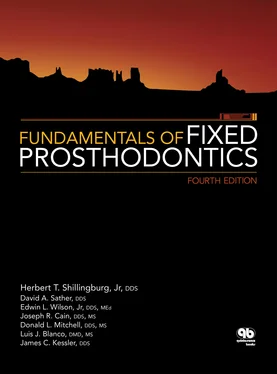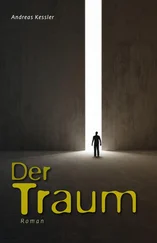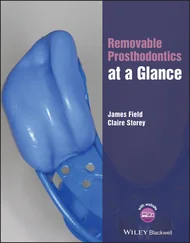| Missing: Mandibular central incisor and lateral incisor Abutments: Central incisor, lateral incisor, and canine Considerations: Inadequate bone support around central and lateral incisors often necessitates their removal. This would require a six-unit fixed partial denture with MCR retainers on the canines. The patient should be warned of the potential for pulpal involvement with resultant endodontic treatment and dowel cores. Anterior guidance should not be excessive to avoid undue lingually directed forces. Retainers: Resin-bonded retainers (only if prospective abutments are large and ideally located) Pontics: Ovate MCRs Abutment-pontic root ratio: 1.8 |
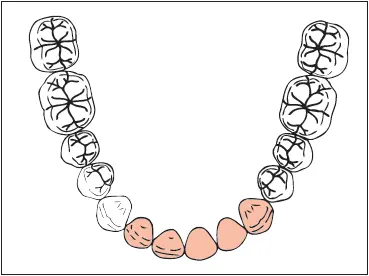 |
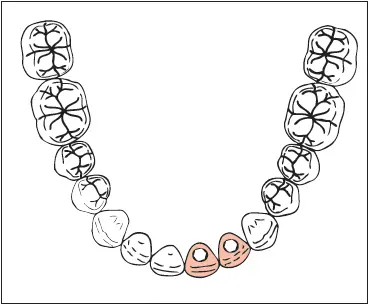 |
Missing: Mandibular central incisor and lateral incisor Implants: 3.3 × 12 mm Considerations: The factor limiting replacement of mandibular incisors with dental implants is the mesiodistal space available. Ideally there should be 12.6 mm of interproximal space. If inadequate space is available, consider extraction of all mandibular incisors. Place two 4.0 × 12–mm dental implants in the lateral incisor positions and fabricate a fourunit fixed partial denture. Splinting the dental implant restoration will reduce rotational forces on the abutment screws, lessening the possibility of screw loosening. Splinting the dental implants will increase restoration strength and stress distribution. Restorations: MCRs over one-piece implants |
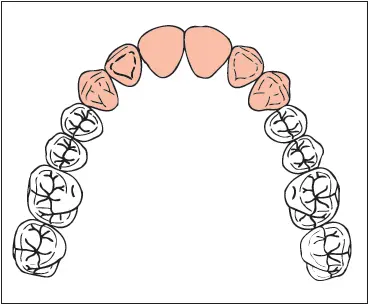 |
Missing: Maxillary central incisors Abutments: Both canines and lateral incisors Considerations: When the bony support for the lateral incisors is poor, it is often best to extract them and lengthen the fixed partial denture span. If the lateral incisors have long roots and crowns, they alone can be used as abutments. Retainers: MCRs Pontics: Modified ridge lap MCRs Abutment-pontic root ratio: 2.3 |
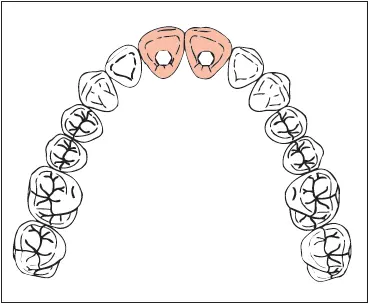 |
Missing: Maxillary central incisors Implants: 4.0 × 12 mm Considerations: A large nasopalatine foramen (incisive canal) may interfere with implant placement. Loss of the facial bone plate may necessitate bone grafting. Splinting the dental implant restoration will reduce rotational forces on the abutment screws, lessening the possibility of screw loosening. Splinting the dental implants will increase restoration strength and stress distribution. Restorations: MCRs over custom abutments (UCLA, Atlantis, or preparable abutments) |
| Missing: Maxillary lateral incisor and canine Abutments: Both central incisors and premolars Considerations: Span length, abutment position, and root configuration can make the use of four abutments desirable. All retainers must have good retention. If the premolars have drifted mesially, it may not be necessary to include the second premolar. Use group function to restore the occlusion. Retainers: MCRs Pontics: Modified ridge lap MCRs Abutment-pontic root ratio: 1.9 |
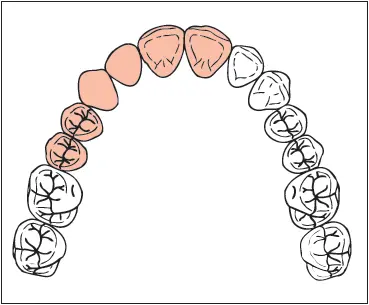 |
| Missing: Maxillary lateral incisor and canine Implants: 3.5 × 12 mm (lateral incisor), 4.5 × 15 mm (canine) Considerations: The loss of a maxillary lateral incisor may result in the collapse of the facial plate of bone, producing a facial concavity, which will require bone grafting. Splinting the dental implant restoration will reduce rotational forces on the abutment screws, lessening the possibility of screw loosening. Splinting the dental implants will increase restoration strength and stress distribution. Restorations: MCRs over custom abutments (UCLA, Atlantis, or preparable abutments) |
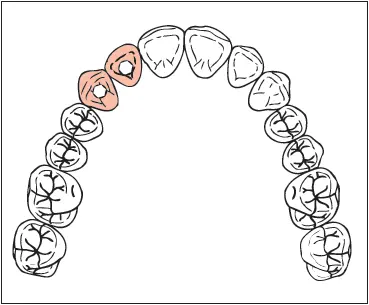 |
| Missing: Mandibular lateral incisor and canine Abutments: Both central incisors and first premolar Considerations: The short edentulous span and the direction of forces on the mandibular canine do not require the use of the second premolar as an abutment. Retainers: MCRs Pontics: Modified ridge lap MCRs Abutment-pontic root ratio: 1.1 |
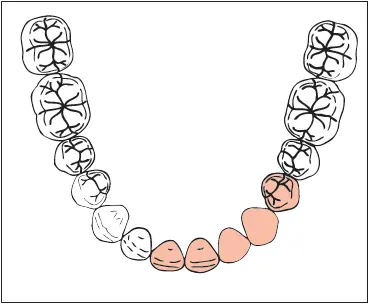 |
 |
Missing: Mandibular lateral incisor and canine Implants: 3.3 × 12 mm (lateral incisor), 4.5 × 15 mm (canine) Considerations: A dental implant is the restoration of choice. Splinting the dental implant restoration will reduce rotational forces on the abutment screws, lessening the possibility of screw loosening. Splinting the dental implants will increase restoration strength and stress distribution. Restorations: MCRs over custom abutments (UCLA, Atlantis, or preparable abutments) |
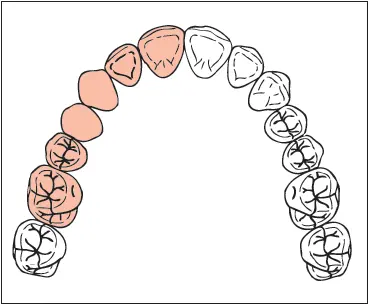 |
Missing: Maxillary canine and first premolar Abutments: Central incisor, lateral incisor, second premolar, and first molar Considerations: Group function should be used. This can be a difficult restoration. Retainers: MCRs on the incisors and second premolar and ⅞ crown on the molar Pontics: Modified ridge lap MCRs Abutment-pontic root ratio: 2.0 |
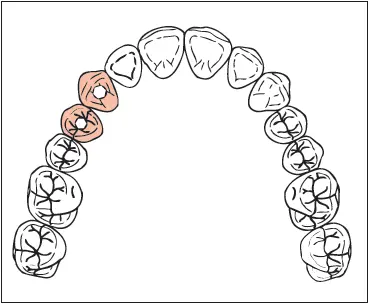 |
Missing: Maxillary canine and first premolar Implants: 4.5 × 15 mm (canine), 4.0 × 13 mm (first premolar) Considerations: The loss of the facial plate of bone will frequently result in a facial concavity requiring implant placement too far to the lingual. This will result in an unnatural lingual contour of the crown and a poor implant emergence profile. To correct this problem, bone grafting is required to eliminate the facial concavity. First premolar implant placement may impinge on the anterior wall of the maxillary sinus. In this event, sinus modification surgery such as sinus grafting or vertical upfracture may be indicated. Splinting the dental implant restoration will reduce rotational forces on the abutment screws, lessening the possibility of screw loosening. Splinting the dental implants will increase restoration strength and stress distribution. Restorations: MCRs over custom abutments (UCLA, Atlantis, or preparable abutments) |
| Missing: Mandibular canine and first premolar Abutments: Central incisor, lateral incisor, and second premolar Considerations: Use group function in restoring the occlusion. This can be a difficult fixed partial denture, but fortunately it is rarely encountered. Retainers: MCRs Pontics: Modified ridge lap MCRs Abutment-pontic root ratio: 1.5 |
 |
| Missing: Mandibular canine and first premolar Implants: 4.5 × 15 mm (canine), 4.3 × 11.5 mm (first premolar) Considerations: The position of the anterior loop of the mandibular canal may interfere with implant placement. Loss of the facial plate of bone may result in inadequate alveolar width. Alveolar resorption may result in insufficient height of bone above the mental foramen. The correction of this anatomical difficulty requires the placement of an onlay bone graft to allow the placement of an implant of sufficient width and length. Splinting the dental implant restoration will reduce rotational forces on the abutment screws, lessening the possibility of screw loosening. Splinting the dental implants will increase restoration strength and stress distribution. Restorations: MCRs over custom abutments (UCLA, Atlantis, or preparable abutments) |
 |
